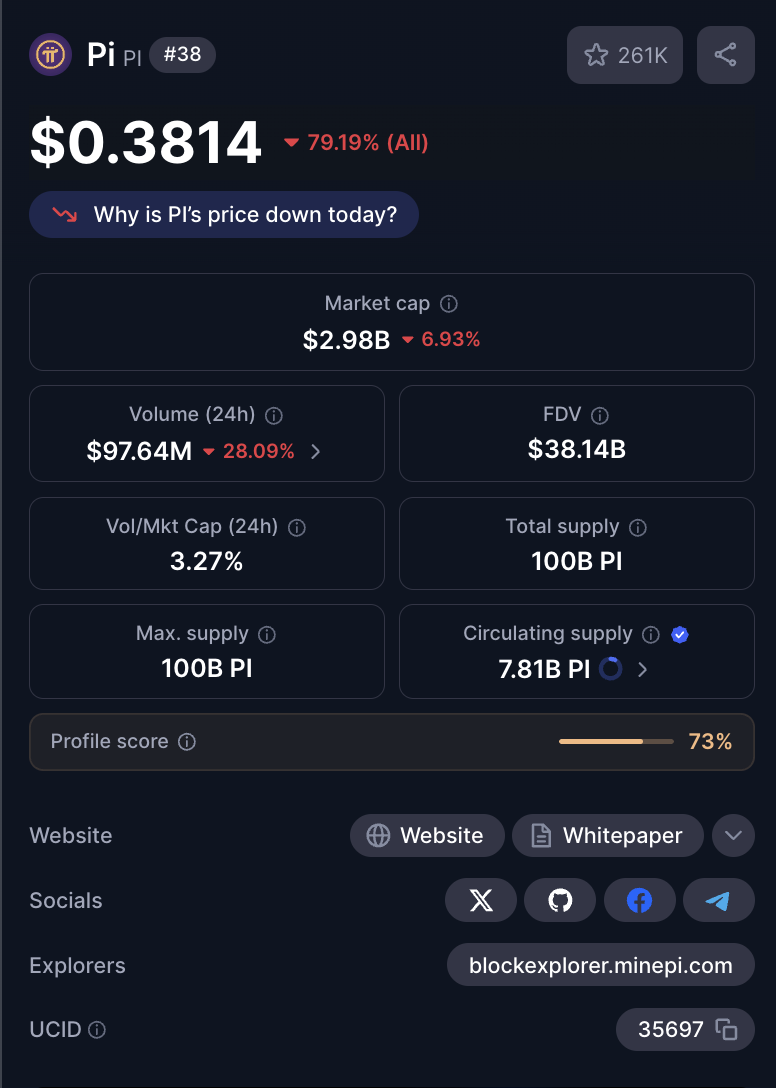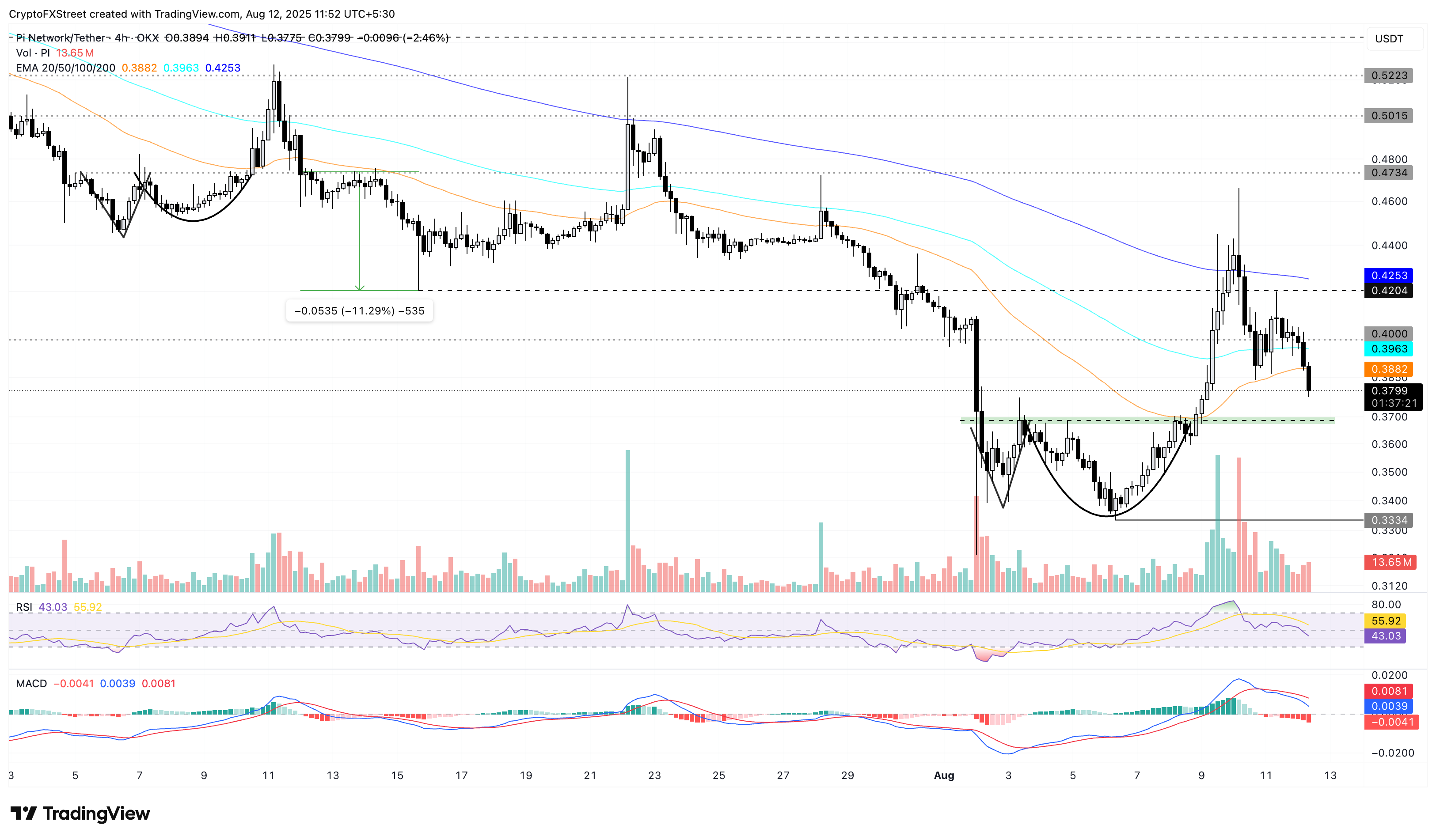Pi Network Price Forecast: PI risks 10% drop as trading volume declines
- PI edges lower towards the $0.3700 support, which previously acted as the neckline of an Adam and Eve pattern.
- Trading volume has decreased by nearly 30% in the last 24 hours.
- The technical outlook flashes the risk of a 10% decline if the bullish pattern’s neckline fails to hold, as previously seen in mid-July.
Pi Network (PI) retraces under $0.4000 at press time on Tuesday, following its peak at $0.4661 on Sunday. The technical outlook suggests a bearish bias as trading volume decreases, with increasing chances of a 10% correction similar to the one seen in mid-July.
Pi Network’s downside risk escalates
The Pi token has dropped by over 3% so far on Tuesday, extending the downtrend that began with the 9% decline on Sunday. The Adam and Eve pattern breakout rally in PI fails to sustain above the 200-period Exponential Moving Average (EMA) at $0.4253 on the 4-hour chart (shared below). This results in a bearish turnaround, breaking below the $0.4000 support and the 50-period EMA at $0.3884.
PI trading volume is down by nearly 30% over the last 24 hours, signaling weaker market participation as traders take a wait-and-see approach.

Pi Network market statistics. Source: CoinMarketCap
The sudden shift mimics the price action of the previous Adam and Eve pattern breakout seen in mid-July, when Pi reversed from the 200-period EMA to invalidate the neckline, back then at $0.4734, resulting in a 10% extended correction. Investors must remain cautious as PI retraces towards the current neckline at $0.3700, which increases the risk of a similar move.
A 10% drop from the $0.3700 neckline would likely test the $0.3334 support level, marked by last Wednesday’s low.
The momentum indicators turn grim as the selling pressure builds up, with the Relative Strength Index (RSI) crossing below its central line on the 4-hour chart. Currently, the RSI stands at 43, suggesting further room for correction before reaching oversold conditions.
Similarly, the Moving Average Convergence Divergence (MACD) indicator displays a declining trend in the average lines after the sell signal from Monday. A renewed wave of red histogram bars below the zero line indicates a rise in bearish momentum.

PI/USDT daily price chart.
Looking up, Pi Network should reclaim the $0.4000 level to revive bullish reversal chances and target the next key resistance, the 200-period EMA at $0.4253.
Bitcoin, altcoins, stablecoins FAQs
Bitcoin is the largest cryptocurrency by market capitalization, a virtual currency designed to serve as money. This form of payment cannot be controlled by any one person, group, or entity, which eliminates the need for third-party participation during financial transactions.
Altcoins are any cryptocurrency apart from Bitcoin, but some also regard Ethereum as a non-altcoin because it is from these two cryptocurrencies that forking happens. If this is true, then Litecoin is the first altcoin, forked from the Bitcoin protocol and, therefore, an “improved” version of it.
Stablecoins are cryptocurrencies designed to have a stable price, with their value backed by a reserve of the asset it represents. To achieve this, the value of any one stablecoin is pegged to a commodity or financial instrument, such as the US Dollar (USD), with its supply regulated by an algorithm or demand. The main goal of stablecoins is to provide an on/off-ramp for investors willing to trade and invest in cryptocurrencies. Stablecoins also allow investors to store value since cryptocurrencies, in general, are subject to volatility.
Bitcoin dominance is the ratio of Bitcoin's market capitalization to the total market capitalization of all cryptocurrencies combined. It provides a clear picture of Bitcoin’s interest among investors. A high BTC dominance typically happens before and during a bull run, in which investors resort to investing in relatively stable and high market capitalization cryptocurrency like Bitcoin. A drop in BTC dominance usually means that investors are moving their capital and/or profits to altcoins in a quest for higher returns, which usually triggers an explosion of altcoin rallies.



